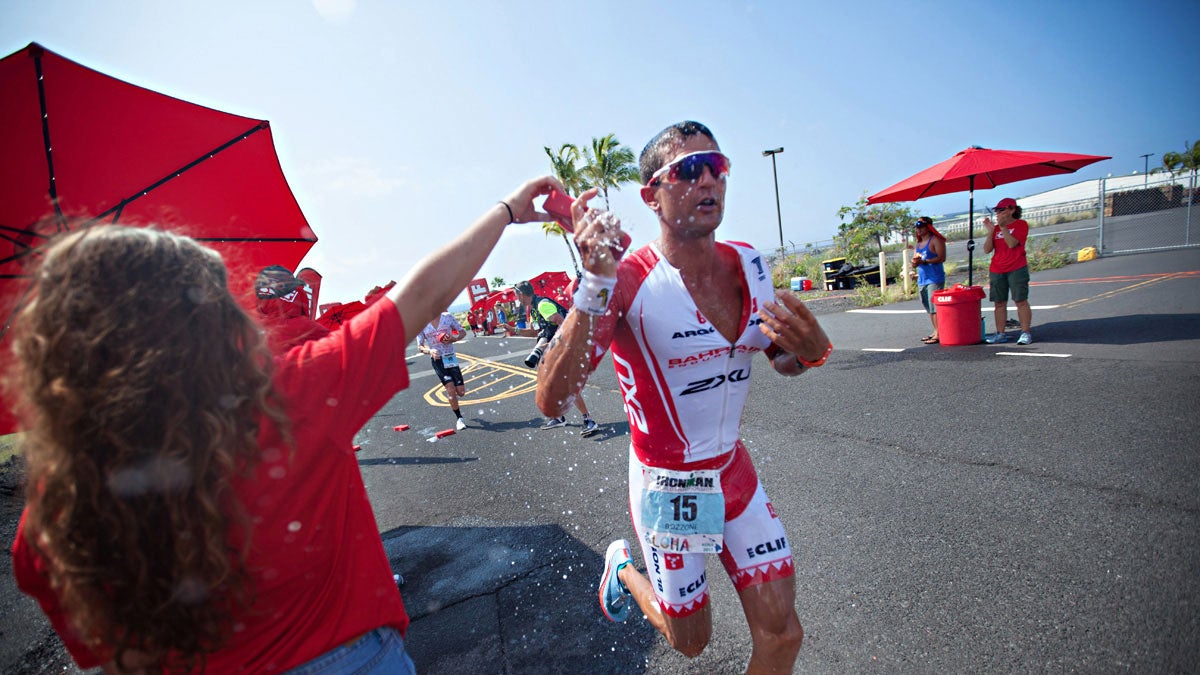Racing in the Heat: Here's How to Deal

Photo: Danny Weiss
At April’s Ironman North American Championship, Sweden’s Patrik Nilsson took 20 extra seconds in T2 to do something strange: He pulled these odd-looking sleeves onto his forearms, and then he took off like a bat out of hell. While his competition struggled with racing in the heat and crumbled in the Texas heat, Nilsson’s pace never wavered on the marathon, en route to the biggest win of his career.
The sleeves were a prototype made by a startup called Omius, which uses the same material found in the heatsink of a computer’s motherboard to keep it cool. By placing the material on the wrists (where there are veins close to the skin’s surface) or the head (where there’s more blood ow than anywhere else in the body), the Omius sleeves and headband claim they can slightly cool blood and lower body temperature. It’s a futuristic solution to an age-old problem for athletes, but it’s important to know your options for staying cool while racing in the heat—even if you don’t have the latest tech.
Racing in the Heat: Evaporative Cooling
The space-age sleeves Nilsson wore work via conductive cooling, which is one of the four methods humans have for losing heat: Radiation (we’re constantly giving off heat into the atmosphere); convection (air or water owing over the skin carries away body heat); conduction (your body gives away heat to anything it touches), and evaporation (which is what makes it possible for humans to do things no other animal can, like an Ironman).
“The process of sweat evaporation is our key evolutionary advantage, and it’s unique in the animal kingdom,” says triathlon coach and sport scientist Paul Laursen. “The key is choosing garments that don’t hinder that process, because it’s our number one way of staying cool on the run.”
The more skin that’s exposed to the air while racing in the heat, the more opportunity there is for sweat evaporation. “The head is a very high blood flow area, so there’s an opportunity to lose a lot of heat by exposing it. A bald head with no hat allows for the most evaporative cooling, but there’s a huge burn risk that probably outweighs it.”
Having your head covered with a breathable hat or Buff also allows you to hold ice on your head, which cools a high blood ow area via conductive cooling while allowing for evaporative cooling as the water vaporizes.
“I’ve tried every trick in the book in Kona,” says 2018 sixth-place finisher Matt Russell. “At the end of the day, nothing works better than ice. I just try to get as much ice all over my body at every aid station—on my head, down my top, and down my pants.”
Humidity is an even greater threat than the sun when it comes to keeping cool while racing in the heat. Sweat evaporation is a nifty little trick when the air is dry, but it doesn’t work so well when it’s muggy. In a place like Hawaii, the air is essentially saturated with water, making it difficult for sweat to evaporate and cool the skin. That means you have to sweat a lot more, and it’s why it’s so important to train your body to become a better sweater before race day.
Heat Acclimatization
“One of the key adaptations we see during the process of heat acclimatization is a significant increase in sweat rate,” Laursen says. “It can be 20 to 30 percent higher after 10 days.”
Most of the literature says it takes at least 10 days to acclimate to hot and humid conditions, but many long-course triathletes cut back significantly on their training during those final days before racing in the heat, making it difficult to fully acclimate in that short a time. That’s why training in the heat during the final four-week build-up to a race like Kona becomes so important.
“Usually my biggest training block is between three weeks and 10 days before the race,” says 2014 Ironman world champion Sebastian Kienle. “And I’m coming from Europe, so I have to deal with jetlag as well. I can’t be trying to overcome jetlag and be acclimating to the conditions at the same time. I either need to get to Hawaii three weeks out, or I need to make sure I’m training in the heat somewhere else.”
The benefits of heat acclimatization before racing in the heat go beyond the massive increase in sweat rate, according to Kienle.
“The mental aspect of getting prepared for the heat is the biggest thing for me. It’s similar to racing at altitude: You have to convince yourself you’re ready for those conditions way before race day.”